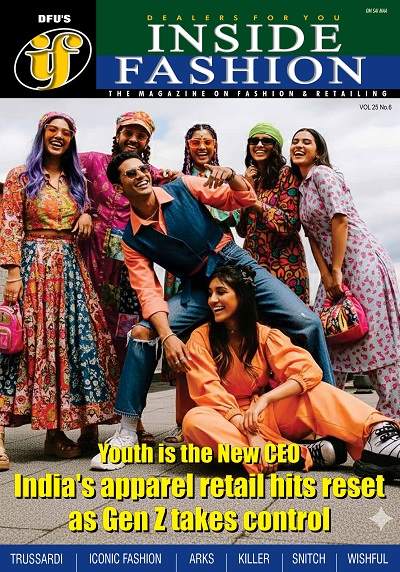Raymond 2.0: The reinvention of India’s most enduring menswear brand

05 November 2025, Mumbai
For nearly a century, Raymond stood as a symbol of Indian elegance and masculine sophistication. Its iconic tagline, ‘The Complete Man’, became more than a marketing phrase it defined generations of middle- and upper-class Indian men. But the world has moved on.
In an era of sneakers at boardrooms and cotton tees at weddings, the formal suit has lost its daily dominion.
Raymond’s latest corporate restructuring described internally as the birth of Raymond 2.0, marks one of the most ambitious reinventions in Indian corporate history.
Read our latest issue
Under the leadership of chairman and Managing Director Gautam Hari Singhania, the 98-year-old conglomerate has divided itself into three net-debt-free entities focused on lifestyle, real estate, and engineering, shedding legacy complexity to become leaner, faster, and future-ready.
This is not just a structural clean-up it’s a bet on a generational shift in how Indian men dress, spend, and define ‘premium’.
Casualization and the rise of Gen-Z
Raymond’s traditional stronghold premium suiting fabrics has been under siege for years. Two structural shifts have led to its decline.
The pandemic permanently redrew fashion’s dress codes. With work-from-home, flexible schedules, and hybrid workplaces, the formal suit has turned from an everyday essential into an occasional indulgence. The global athleisure takeover has reshaped wardrobes and reduced formalwear’s share of men’s apparel by double digits since 2020.
The Gen-Z paradox
India’s youngest workforce cohort Gen Z (born 1995-2010) has radically different sartorial priorities. Nearly 78 per cent of Gen-Z consumers prefer comfort and versatility, gravitating toward athleisure, denim, and cotton-rich casuals rather than traditional wool blends.
Their fashion decisions are shaped by micro-influencers, not TV ads.
They trust Instagram and TikTok trends over store displays. Gen-Z demands transparency, authenticity, and sustainability, qualities often missing from legacy brands. They’re also twice as likely to use digital wallets and buy online compared to millennials.
For Raymond, this means one thing: Beyond suits a focus from ceremonial to everyday relevance, capturing a greater share of the Indian man’s wardrobe.
Apparel brands and retail reinvention
To stay relevant, Raymond Lifestyle (RLL) the demerged lifestyle arm has launched a comprehensive revival blueprint titled ‘Accelerate the Growth’ and ‘Build the New’.
These programs are reshaping both products and distribution. Under these Raymond’s flagship brands are being actively repositioned for younger, more casual audiences.
Park Avenue is moving beyond suits with Active Fit and Ath Mod Fit jeans, T-shirts, and stretch chinos. The goal: lower the brand’s average consumer age while preserving its premium aesthetic.
Textile Innovation remains a cornerstone, with new lines like ‘Fearless’ (spill-resistant, stretchable, and crease-free fabrics) and Vibez a colorful, bold-printed shirting range designed to match India’s vibrant casualwear boom.
Ethnix by Raymond, the ethnicwear label, is scaling fast. With wedding and ceremonial dressing booming post-pandemic, RLL aims for a 7 per cent market share in men’s ethnicwear by 2027, expanding via exclusive Ethnix brand stores.
New categories such as innerwear and sleepwear mark Raymond’s entry into daily-use essentials higher-frequency, resilient segments that promise steady volume growth. These initiatives highlight Raymond’s attempt to translate its formalwear heritage into a lifestyle ecosystem for the new Indian man.
Retail & digital transformation
Raymond’s distribution strategy once anchored in premium high-street stores is now pivoting toward an agile, omnichannel model emphasizing reach, affordability, and personalization.
Raymond plans to add 150-300 exclusive brand outlets annually, predominantly through the Franchise-Owned, Franchise-Operated (FOFO) model. This lowers capital expenditure and enables rapid entry into Tier-II, III cities, India’s next consumption frontier.
Meanwhile, the company has introduced a made-to-measure digital experience, combining home/office stylist visits with virtual measurements and a ‘Perfect Fit Guarantee’. This merges premium bespoke heritage with modern convenience.
RLL is deploying AI/ML to refine demand forecasting, improve inventory efficiency, and develop rapid digital storefronts essential for competing with agile fast-fashion rivals.
Raymond is also transitioning from TV-heavy advertising to content-driven engagement collaborating with relatable influencers who embody authenticity and style over status. This multi-channel approach signals Raymond’s evolution from a manufacturer-led textile company into a consumer-first fashion ecosystem.
Raymond 2.0 restructuring
Raymond’s corporate simplification approved by the NCLT in June 2025 is more than an exercise in balance-sheet hygiene. It’s a calculated bet on unlocking hidden value and freeing each business vertical to pursue independent growth.
Branded textile (47.5 per cent of revenue): The dependable, cash-generating core remains a stabilizer amid turbulence, supporting innovation in other verticals.
Branded Apparel (24.5 per cent of revenue): Now positioned as the main growth engine, this segment targets a top-line CAGR exceeding 22 per cent, driven by aggressive retail expansion and product diversification.
Real Estate (Raymond Ltd.): With a zero-debt status post-FMCG divestment, the real estate arm is projected to unlock Rs 40,000 crore in potential revenue from its Thane land bank and joint development projects a valuation anchor for the demerged structure.
By channeling the proceeds from the FMCG sale to eliminate debt, Raymond has emerged financially lighter and strategically sharper, a rare feat in India’s corporate landscape.
Chairman Gautam Hari Singhania encapsulates the transformation as he says, “We’re finding a young customer... We’re at a particular point. We don’t go below a particular point.” The message is clear: while Raymond embraces change jeans, T-shirts, and digital-first retail it refuses to dilute its premium DNA.
The brand’s reinvention is less a departure from its heritage and more a reinterpretation of it for a new generation. From The Complete Man to the Contemporary Man Raymond’s second act is a lesson in strategic resilience how a legacy brand can rewrite its destiny not by abandoning its past, but by reimagining it.
Thus Raymond’s reinvention underscores a broader truth about India’s consumption story: tradition and transformation can coexist.
As the ‘Complete Man’ evolves into a digital-native millennial and Gen-Z hybrid, Raymond 2.0 stands at the crossroads of heritage and reinvention—where suiting fabric meets stretch denim, and the showroom meets the smartphone. If successful, this transformation could redefine not just a brand but an entire category of Indian menswear for the next decade.










